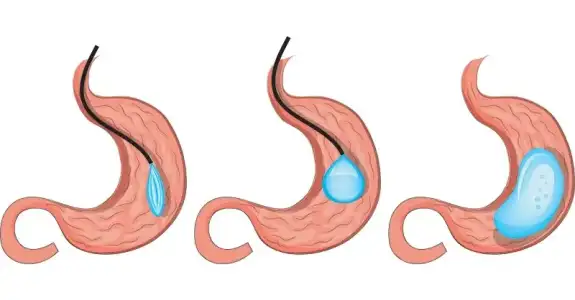What is a gastric balloon? What are the Benefits? Who Can Use?

What is a gastric balloon, what is it for, what are its benefits, is it safe and who can use it? This page will give you information about gastric balloon placement. If you have a random question, you should ask your doctor or other relevant healthcare professional. A gastric balloon is a small silicone balloon filled with saline (saline). When filled, it is the size of a small orange and takes up about half of your stomach. The balloon is usually filled in the middle of 450 to 600 ml, but this can vary from person to person.
What is a gastric balloon?
A gastric balloon is an inflatable silicone balloon that is placed in your stomach. It works by making you feel full sooner so you eat less.
Intragastric balloon placement is a weight loss procedure that involves placing a saline-filled silicone balloon in your stomach. This helps you lose weight by limiting how much you can eat and making you feel full faster.
If you are concerned about your weight and diet and exercise have not worked for you, the intragastric balloon procedure may be an option. Like other weight loss procedures, the intragastric balloon requires a commitment to a healthier lifestyle.
To ensure the long-term success of the procedure, you need to make lasting healthy changes in your diet and train regularly.
NOT PERMANENT Gastric balloons are designed to stay in the stomach for six months. It is deflated after six months and removed by endoscopy.
Who Can Use the Gastric Balloon?
An intragastric balloon may be an option for you if:
- Your body mass index (BMI) is between 30 and 40
- If you have not had stomach or esophageal surgery before
Gastric balloons are not a true choice for anyone who is overweight. A screening process will help your physician see if the procedure would be beneficial for you. Currently, the cost of inserting and removing the intragastric balloon may not be covered by health insurance and will therefore be an out-of-pocket expense.
What are the health benefits of gastric balloon?
In addition to weight loss, gastric balloon patients can experience any of the many health benefits associated with weight loss. Improvements can be seen under the following conditions:
- type 2 diabetes
- Hypertension
- Sleep apnea
- Back pain
- high cholesterol
- Osteoarthritis (joint pain)
What Are the Risks of Gastric Balloon Faithful?
Pain and nausea affect approximately one-third of people shortly after insertion of the intragastric balloon. However, these symptoms usually only occur after balloon insertion. several days takes. These symptoms can often be treated at home with oral medications.
After a slight intragastric balloon placement serious side effects visible. Call your doctor immediately if you have nausea, vomiting and abdominal pain at any time after surgery.
One potential risk includes deflating the balloon. If the balloon deflates, there is also a risk that it will pass through your digestive system. This may require an additional procedure or surgery to remove the device. to clog why could it be. Other possible risks include excessive swelling, acute pancreatitis, ulcers, or a hole (perforation) in the stomach wall that may require surgery to correct.
How Much Weight Does a Gastric Balloon Lose? results
An intragastric balloon can make you feel full faster than usual while eating, which often means you eat less. One reason may be that the intragastric balloon slows the time it takes to empty the stomach. Another reason may be that the balloon appears to be changing levels of appetite-controlling hormones.
The amount of weight you lose also depends on how much you can change your lifestyle habits, including training. Based on a summary of currently available treatments, approximately 7% to 15% of body weight loss is typical during the six months following intragastric balloon insertion. Total excess weight loss ranges from 30% to 47%.
When weight loss procedures don’t work
After a random weight loss procedure or surgery, it is possible not to lose or regain significant weight, even if the procedure itself actually works. This weight gain can happen if you don’t follow the recommended lifestyle changes. Permanent healthy changes in your diet are necessary, along with regular physical activity and training, to prevent weight gain.
- On-Site Comments
















Comment